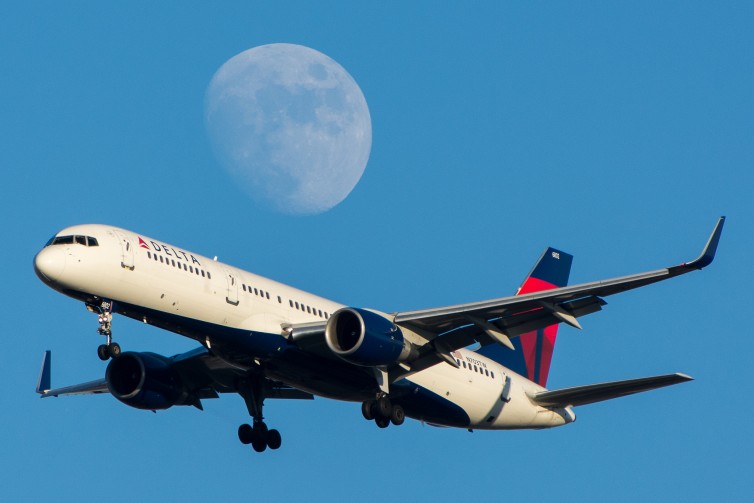
A Delta Air Lines Boeing 757 – Photo: Jason Rabinowitz
Every month, the United States Department of Transportation (DOT) releases a load of airline statistics ranging from on-time performance rankings to lost bag rates and simple info requests. Within the monthly data dump sits the number of complaints the DOT received about airlines for that particular month. You’ve probably seen the new headlines like “airline complaints spike in 2014,” or something like that. That data comes from the DOT releases.
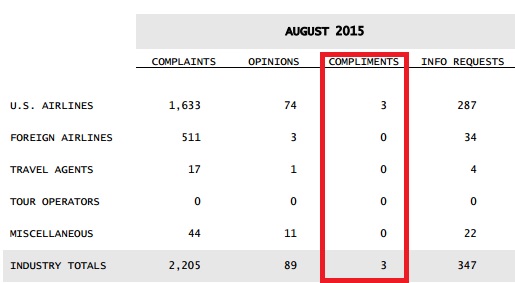
Buried in the 47-page monthly DOT report, the word “compliment” is mentioned twice
Buried in a recent release, I noticed that the DOT also reported airline compliments in addition to complaints. While complaints sometimes tally over 2,000 per month (2,205 in August 2015), the number of compliments ranges anywhere from none at all to maybe one or two. In the August 2015 release, a whopping three airline compliments were received, and I couldn’t help but wonder what they said. I simply had to know more.
Recently, I received an email from Blaine asking me a question about awarding international routes. It was a great question that I did not know the answer. I was talking to Dan Webb, who runs the site Things in the Sky on BoaringArea, and was happy to take on the answer. Here is his story:
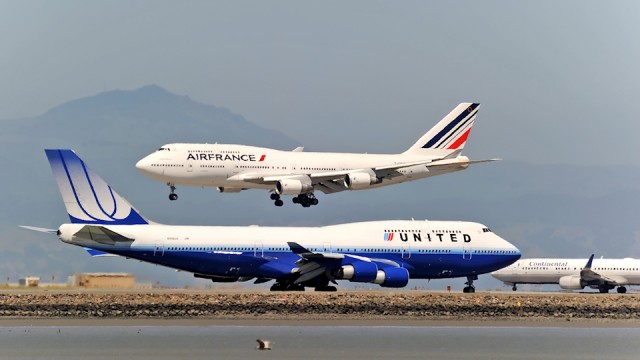
United Airlines and Air France Boeing 747-400s at San Fransisco.
Here is part of an email David recently passed along from a reader:
“’¦how is the DOT involved in the awarding of international routes? From what I gather, domestic routes at up to the discretion of an airline (if it makes business sense, they fly it) but it appears that a myriad of airports and airlines compete for international routes. Often, these are not even to the same city pairs – just takeoff and landing slots within the US?”
Unfortunately, there’s no simple answer to this question because it varies by country. In fact, the State Department has a handy page that lists every aviation agreement between the United States and other countries.
As Blaine mentioned, domestic routes are completely in control of the airlines. (The only time one might see the DOT assigning a route is through the Essential Air Service program, but airlines bid for those contracts.)
In some cases, open skies agreements allow for similar flexibility. The most notable example is the agreement between the US and the European Union, which gives carriers the freedom to fly from any point in the US to any point in the EU, and vice-versa. (One example is the short-lived Air France service from Los Angeles to Heathrow.)
Other times, agreements between the US and other parties can be a bit more restrictive. Mexico is a good example. In most markets, up to two carriers from each country are allowed to provide service, though three carriers are allowed in a few. But while the agreement does put a cap on the number of carriers, airlines still decide if they want to serve a market or not (but they do need government approval to launch service).
Another example is the current agreement between the US and China. In one recent example, new frequencies between the US and China became available, and a bunch of airlines competed for the slots. The DOT then decided what carriers would end up receiving the frequencies.
If issues like this interest anyone, the process of applying for new routes is quite transparent, with relevant filings available at Regulations.gov. I often go that website to look up all DOT filings and then sort them by date to see what’s been happening recently.
Image: iflyfsx
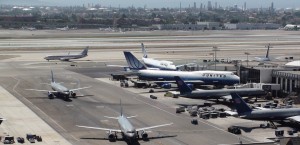
Planes at LAX. Photo by David Parker Brown
The US Department of Transportation announced more regulation on the airline business this week and it has me a bit confused. The airline industry is already one of the most regulated industries in the US and some of these new rules just seem silly. Let’s take a look at them one by one:
Lost Bag Means Bag Fee Refund
I actually like the concept of this — it makes sense to me. If I am paying an airline money to handle my bag, it makes sense that I be refunded that fee if the bag is lost at no fault of my own. However, I am not to keen on the government forcing airlines to do this.
Tarmac Delay Rule to Include International Flights
Even though I love flying, I hate being stuck on the tarmac. I can sit on a plane for 15 hours while flying and be fine since I am making progress. However just sitting on the tarmac going no where just bites. The DOT already has regulated domestic flights cannot be sitting on the tarmac for more than three hours and now extends that to international flights. I am already not a fan of the domestic three hour tarmac rule and even more against international flights.
Not all airports can handle international flights the same. If a flight needs to be diverted to an airport that normally doesn’t handle international flights, it is going to take time to get the proper personnel there.
Now that airlines could face huge fines with international flights to the US, they will be more likely to cancel them. Unlike many domestic flights, which have multiple flights per day, many international flights will only have a few flights per week. That means you could be stranded in another country for days versus being stranded on the tarmac in the US for a few hours.
More Money for Bumped Passengers
Over booking flights always makes sense on paper, but is super annoying when you are the person that gets bumped.
When an airline knows that on average there will be a certain percentage of people that won’t show up for a flight, so they oversell, that makes good business sense. Good business sense doesn’t always means good customer service. The fees will be increased from $400 to $650 for short delays and $800 to $1,300 for longer ones.
It does annoy me that many airlines do not seem to do the right thing when it comes to bumping passengers and quite a few have been fined. Out of all the rules imposed by the DOT, this is the one actually angers me the least.
Disclose All Fees
This seems to duplicate what airlines already do. Maybe I have missed something, but every airline I have ever booked with clearly states on their website what they charge for. Sure some might be a little more tricky than others, but many businesses operate the same way. Have you ever tried to buy a car and get additional fees? Of course.
What is really bothersome is the government is looking to regulate how airlines show their fees. Why does the government feel the need to force airlines to do this, but not other industries?
Add Taxes and Government Fees to Advertised Fares
This one makes the least sense. What other industry is required by the government to include taxes and government fees to their advertised prices?
Most states have tax and people know they will pay tax. Can I walk into a dollar store with $1 and buy something? Nope, where I live I will need $1.09 and I know that. I think this goes to show that the airline business is treated unfairly and “consumer protection” groups are going too far to discriminate against airlines. I just wish the government wouldn’t play along.
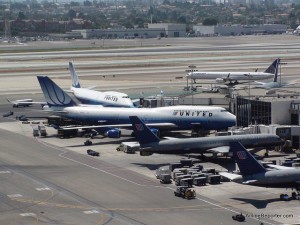
United Airlines aircraft at LAX. Photo by AirlineReporter.com
If you keep up with my opinions, you know I am not a huge fan of the three hour tarmac delay rule. I am all for passengers being treated correctly, but not for forcing airlines to do what is not always best for passengers. What happens when an airline honestly thinks they break the three hour tarmac rule and reports it to the Department of Transportation (DOT)? They get fined, that’s what. Dan Webb on his blog, Things in the Sky, took a look at recent incidents involving United, the DOT, the three hour fine, and craziness.
Remember, this is still a new rule that went into affect in April. If an airline violates the rule, it could mean huge fines. How huge? Like $27,500.00 per passenger huge. With the rule being new and the consequences being severe, airlines are going to be cautious to not only obey the rule, but be sure to properly report when they break it.
On May 26th of this year, four mainline (non-United Express) flights bound for Denver had to be diverted to Colorado Springs due to poor weather. After hitting the two hour mark, flight attendants made sure that passengers were being fed (via snack foods), which is following the proper procedure of the three hour rule. But feeding passengers stuck on the tarmac is not something new for United…it is something they would have normally done even before the rule.
Not too long after, air stairs and buses were pulled up to allow passengers to get off, if they wanted to. Some decided to de-plane, but most stayed on board. Since the aircraft was away from the gate for more than three hours, United reported the incidents to the DOT.
The DOT reviewed the report, looking to see if they needed to issue a hefty fine. They realized that even though the aircraft were sitting on the tarmac for more than three hours, United fed the passengers and gave them the choice to get off the plane. Cool…no harm, no foul, no rules broken. Oh but wait! The DOT decided to fine United $12,000.00 for filing a false report…say what?
I might not agree with this tarmac rule, but I understand where it is coming from. The goal is to make sure that those “evil” airlines don’t hold passengers captive in an airplane for entirely too long. United followed the rule, giving passengers a choice. One way or another everyone safely made it to their destination. The last plane left after a 4hr 40min delay, but all four made it to Denver that day. It seems crazy that the DOT would issue a fine for United being overly cautious on a very new rule that has big consequences.
I agree if an airline had no reason to issue the report and genuinely wasted the DOT’s time, they should be fined. However, United was trying to be transparent. Luckily for them, they only have to pay $6000.00 of the fine as long as they behave themselves and don’t do this again.
I spoke with United about this situation and they told me, ’œIt is unfortunate that our effort to be fully transparent with the DOT resulted in our inadvertently reporting four flight delays where we complied with regulations and with our own procedures to ensure the comfort and safety of our customers and employees.’
There are a lot of people out there saying the tarmac rule is so far a success. I entirely disagree and await this busy winter season to see how the rule works out.
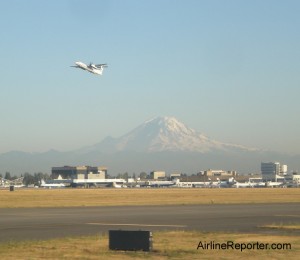
Why would you expect delays with nice weather like this seen in Seattle over the summer? Let's wait until winter DOT!
The Department of Transportation (DOT) is working with some funny math and concluding that the tarmac delay rule is working. Both Aubrey Cohen with the Seattle PI and Brett Snyder with CrankyFlier.com take a closer look at their math and don’t come to the same conclusions.
Instead of re-inventing the wheel, please read:
* DOT’s report, ’œLong Tarmac Delays in July Down Dramatically from Last Year’ that claims delays are down and cancellations have just a, “slight increase.”
* Snyder’s post, “DOT Continues to Claim Tarmac Delay Victory Despite 20 Percent Rise in Cancellations,” which shows how he doesn’t think a 20% increase in canceled flights is considered “slight.”
* Cohen’s article, “Cancellations inch up, or surge, thanks to tarmac rule,” takes a look how it might be a 20% rise, but when dealing with such small numbers, is it a big increase?
After taking a look at all three, I am not even close to admitting defeat (I am against the tarmac delay rule). It just started April 29th of this year and has only seen the summer. I am waiting to see what happens over the winter. Yes, I imagine delays will be down, but cancellations will be up — quite a bit. If I am wrong, I will more than happy eat my words, but I have a feeling there will be a lot of angry passengers this winter season.





